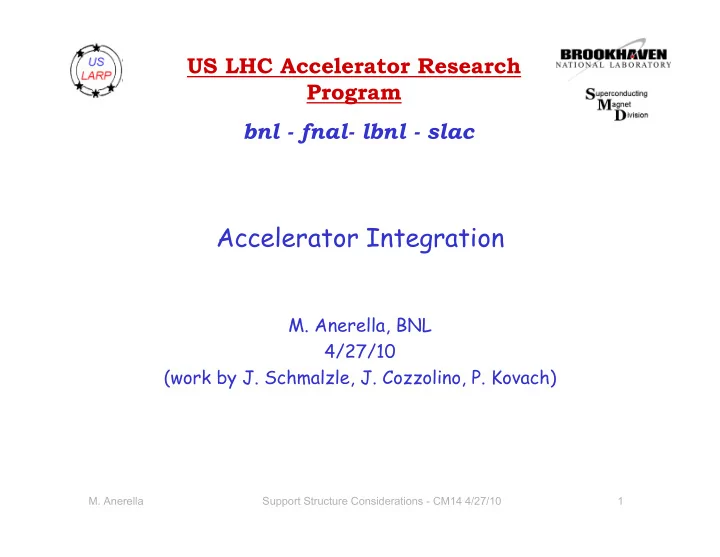

US LHC Accelerator Research Program bnl - fnal- lbnl - slac Accelerator Integration M. Anerella, BNL 4/27/10 (work by J. Schmalzle, J. Cozzolino, P. Kovach) M. Anerella Support Structure Considerations - CM14 4/27/10 1
Outline • Brief Review from CM13 • Collar progress since then • Collaring tooling progress since then • Work to go M. Anerella Support Structure Considerations - CM14 4/27/10 2
Goals (from CM13) • Employ all of the benefits of the existing LQ/HQ shell structures • Add provisions for 2K helium cooling – 80mm heat exchanger holes • Improve alignment features – provide keys from coils to helium vessel • Complete cold mass – helium vessel • Enhance reliability, manufacturability (reduce cost) • Develop a design which is accepted for use in LHC by CERN M. Anerella Support Structure Considerations - CM14 4/27/10 3
Updated Support Structure Inner / outer yoke Alignment / Load Keys + (narrow) Load Shims Helium Holes Collar alignment keys Loading Keys aluminum Tapered collar keepers collars Bladders / yoke inserts Inner Yoke Lams Aluminum Shell Outer Yoke Lams SST Shell Cold mass alignment supports M. Anerella Support Structure Considerations - CM14 4/27/10 4
Alternate Collar Investigation • Keys replaced by “keepers” – Allows for 2x the collar key bearing area, therefore ½ x the collar stress for a given load – Potential for higher coil loading at 300K – Results in cheaper collars (single part style, no welding or pinning needed) → decision to be based on technical performance + cost M. Anerella Support Structure Considerations - CM14 4/27/10 5
Alternate Collar FEA Work is presently underway: •Collar loading now •Cool down, Lorentz forces next M. Anerella Support Structure Considerations - CM14 4/27/10 6
Updated Collaring Concept Review: “Bladder-technology” based: •Quad symmetry assembly •Provide precise alignment during assembly •Lower capital cost, easily incorporated into R&D budget •Easily expanded from 1m to 8m •Assembly process developed (see back-up sheets) Updates: •Revised for updated collar design •Minor corrections to keys, platen travel, etc. (4) Key bladders (4) Collar bladders •Bladder development ( next slide ) M. Anerella Support Structure Considerations - CM14 4/27/10 7
Bladder Development • Designed for ~ 6mm stroke • Stainless steel extrusion, welded only at ends – Sample ordered, delivery ~ now • End fittings transition from extension to fixed pressure fitting – Prototypes to be ordered 4/10 → single bladder assembly (~ 6” to 12” long) to be tested before tool fabrication begins M. Anerella Support Structure Considerations - CM14 4/27/10 8
Next task – Axial Loading FEA •Stainless steel end plate, set screws support axial loads •Also serves as an element of pressure vessel M. Anerella Support Structure Considerations - CM14 4/27/10 9
Schedule – work to go M. Anerella Support Structure Considerations - CM14 4/27/10 10
Back-up (CM13) slides • Goals • Design philosophy • Picture of laminations from progressive die • Collaring process • Assembly steps M. Anerella Support Structure Considerations - CM14 4/27/10 11
Design Philosophy • Traditional aluminum collars – apply low initial prestress to coils – Guarantee alignment from coil pole to collar o.d. (no sliding/mating of alignment features during assembly) – Provide reliable geometry – Prohibit over-compression of coils by means of mechanical stop • Circular contact between collar and inner yoke – Greater contact provides full support - geometric repeatability, lower contact stresses • Shift inner-outer yoke boundary outward radially – Enables incorporation of helium heat exchanger holes – Enhances flux return – Allows for greater surface area of bladders, loading keys → lower pressure • Shift yoke parting planes to midplane – Allows for continuous alignment from coil to exterior of helium vessel – Coil deflections under full excitation are acceptable • Utilize fewer, cheaper parts – Inner and outer yokes made from common lamination in a progressive die • Guaranteed alignment of critical features • Cheapest method of manufacture – Simple keys, shims inserted easily through procedural changes • Support axial forces through sst shell – allows greater helium, flux space M. Anerella Support Structure Considerations - CM14 4/27/10 12
Laminations from a progressive die M. Anerella Support Structure Considerations - CM14 4/27/10 13
Collaring Process M. Anerella Support Structure Considerations - CM14 4/27/10 14
Assembly process • Collar coils to fairly low load. • Assemble into yoke. Under size keys maintain alignment , allow outer yoke to be closed against inner yoke. M. Anerella Support Structure Considerations - CM14 4/27/10 15
Assembly process • Place yoke assembly onto thin liner / sled. • Temporary end plates and tie rods hold yoke together. M. Anerella Support Structure Considerations - CM14 4/27/10 16
Assembly process • Pull assembly into shell. Clearance because outer yoke is clamped to inner yoke. M. Anerella Support Structure Considerations - CM14 4/27/10 17
Assembly process • Place onto precision supports, providing alignment of yoke during assembly • Use bladders to load coils / shell. – 1 or 2 quadrants at a time (as now) – Rotate 90° and repeat • Install support keys / shims. M. Anerella Support Structure Considerations - CM14 4/27/10 18
Assembly process • Install into helium vessel (loose clearance fit) • Install cold mass supports / alignment fiducials on yoke through access holes. • Install end plates – set screws to load coil ends. • Install cover patches onto vessel M. Anerella Support Structure Considerations - CM14 4/27/10 19
Support Structure • Complete electro-mechanical assembly • Install end domes, cradles aligned to cold mass supports / fiducials to complete helium vessel. M. Anerella Support Structure Considerations - CM14 4/27/10 20
Support Structure • Cut away view Stainless steel end plate supports axial loads, completes pressure vessel M. Anerella Support Structure Considerations - CM14 4/27/10 21
Recommend
More recommend